| |
|
Roswell |
New Mexico |
USA |
Horizontal Dial |
Dial 490 |
| A beautiful bronze sundial sits on a pillar of rough marble. It was given to the Library by the Roswell Womens Club at the turn of the 20th century. Unfortunately the dial is damaged, but the Roswell Womans Club is searching for someone to repair the dial. |
| |
| |
|
Cuencame |
Durango |
Mexico |
Vertical Dial |
Dial 489 |
| This vertical dial is 2m tall by 1.2 m wide and sits atop a quarried column nearly 7 m high. The gnomon on each face is approximately 60 cm long, and 16-19 mm in diameter. Each face has Roman numerals to indicate apparent solar time from 6am to 6pm. Alpha and Omega Greek letters. A carved cross at the twelve hour line. Inscribed "1904" |
| |
| |
|
Monterrey |
Nuevo Leon |
Mexico |
Equatorial Dial |
Dial 488 |
| This equatorial dial is just over 3 m in size, made of iron. Along the equatorial band are twelve Roman numerals to indicate apparent solar time and twelve Arabic numerals to indicate standard time. The outside of the equatorial band has zodiac constellations. There are also solstice and equinox discs at the gnomon. There is a plaque for the equation of time and an explanation of time corrections next to the sundial. The dial sits on a 1 m high stone base. |
| |
| |
|
Torreon |
Coahuila |
Mexico |
Vertical Dial |
Dial 487 |
| This is a stone cube 3.5 m high with four vertical dials. Each dial face is about 2.2 m high by 1.25 m wide The South and North faces have Arabic numerals to indicate solar time from 6am to 18hrs, with marks every 15 minutes. The East face has numerals from 6am to 12pm and the West face complements from 12pm to 18hrs. These faces have half hour marks. The South face has seven declination lines, constellation dates, analemma line, zodiac symbols, and equinoctial and solstice lines. A curve to indicate light and shadow hours all the year is on each face. A square base on quarry. At the north-east corner are the carved names of the designer Miguel Bertran de Quintana and builder Cirilo Nunez.
Note: because of the sundial size and latitude, it was necessary to extend the four vertical faces of the sundial into the horizontal plane to indicate the summer solstice line and 11:30 and noon hours of summer. |
| |
| |
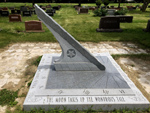 |
Des Moines |
Iowa |
USA |
Horizontal Dial |
Dial 486 |
| This large horizontal dial is approximately 6-foot square with a 4-foot gnomon. The dial face is done in two tones of marble. Time is indicated by radiating hour lines to nearly the dial's edge and graced with Roman numerals. The gnomon has an emblem of the masonic star on west side, and the masonic square and compass on the east side. |
| |
| |
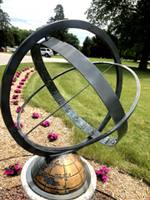 |
West Des Moines |
Iowa |
USA |
Armillary Sphere |
Dial 485 |
| This is a 24-inch armillary sphere on top of a portion of a brass globe showing continents and latitude lines o The dial points generally south, aligned for beauty, not function. The base is aligned to a general northern direction. The time equatorial band, meridian circle and improper horizontal band are painted black. Elegant polished brass Arabic hour numbers half-hour brass time beads indicate the time on the equatorial band. Sits on a concrete column several feet high. |
| |
| |
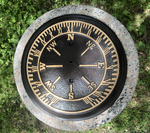 |
Des Moines |
Iowa |
USA |
Horizontal Dial |
Dial 484 |
| A small 8-inch diameter dial of bronze with black background and highly polished Roman numbers and hour lines. An eight-point compass rose, equally well polished occupies the majority of the center. The gnomon is missing. The dial plate is set at an incorrect orientation. The dial sits on a 4-foot high fluted granite column. |
| |
| |
 |
Des Moines |
Iowa |
USA |
Horizontal Dial |
Dial 483 |
| A very large and striking horizontal dial 50 feet in diameter with a 15 foot tall metal gnomon. Dial has standard time marked in brass Roman numerals and daylight saving time in smaller circular brass discs with Arabic numerals. The 16 large granite markers radiating from the center are artistic effect only and to not mark time. This large monumental dial is surrounded by a knot-garden. The dial granite base is raised 2.5 feet.The knot-garden theme is continued on the upper, center level. |
| |
| |
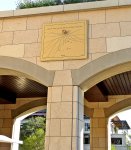 |
Palo Alto |
California |
USA |
Vertical Dial |
Dial 482 |
| A vertical declining dial approximately 45 x 55 inches. Made of aluminum and brass. Shows the hours from 8 am to 5 pm using analemmas. Analemmas are bounded by the summer and winter solstices and a straight line through them shows the equinox. Daylight time is shown using Roman numerals, with standard time shown in Arabic. In keeping with the motto, a simple equation is written on the dial face, d/dt is not equal 0.
Designer Ronald Bracewell used an oculus, a disk with a central hole, standing 8 cm in front of the dial face. The disk casts a shadow with a bright sunlight dot to indicate both time and season. Hour lines include longitude correction.
This has been relocated; it was previously hanging free below a south facing wall, facing the Terman Engineering Building. Dial is now located on the wall of a covered walkway area. |
| |
| |
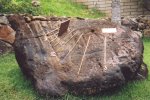 |
Honolulu |
Hawaii |
USA |
Vertical Dial |
Dial 481 |
| An elegant vertical declining and reclining dial built on the sloping face of a large lava boulder. Total size of the dial is 4 1/2 x 6 feet and uses a half-inch thick copper gnomon 6 x 10 inches. Hour lines and numerals at 9, 12, and 3 are of brass. The dial is corrected for longitude and was designed to fit its deep valley location and orientation of the boulder. Tradition holds that these rocks have spirits and must be treated with respect. |
| |
| |
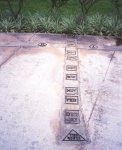 |
De Dedo |
Guam |
USA |
Analemmatic Dial |
Dial 480 |
| This analemmatic dial approximately 10 x 20 feet set into concrete. At the low latitude of Guam, the gnomon standing spot extends outside to ellipse of hour markers. Between April and September the shadows are very short near the noon hour and are difficult to read. |
| |
| |
 |
Council Bluffs |
Iowa |
USA |
Obelisk or Vertical Gnomon |
Dial 479 |
| Vertical gnomon casting its shadow onto a plaza in front of the city library. Modernistic design.
This dial has been scheduled for removal as of October, 2010 due to cracking and to make more green space. |
| |
| |
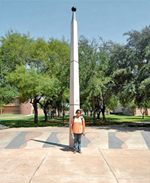 |
Edinburg |
Texas |
USA |
Obelisk or Vertical Gnomon |
Dial 478 |
| A vertical gnomon 19.58 feet tall projects its shadow onto a modernistic courtyard. The courtyard has inlays showing the hour corrected for the equation of time, give a sinuous set of curves to the hour lines. |
| |
| |
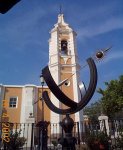 |
Colima |
Colima |
Mexico |
Equatorial Dial |
Dial 477 |
| A bright bronze equatorial sundial with a stainless steel equatorial band. The gnomon has an analemma for the correction of time and a colorful sunburst near the northern end of the rod. |
| |
| |
 |
Santa Rosa |
California |
USA |
Horizontal Dial |
Dial 476 |
| This bronze horizontal dial is about 14in (356cm) in diameter with simple hour lines radiating from the gnomon foot to the circumference where Roman hour numbers mark the hours from 5am to 7pm The dial stands in the middle of a bronze lotus flower about 80in (2m) in the round. |
| |
| |
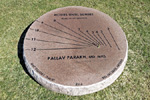 |
Greenfield |
Massachusetts |
USA |
Hours to Sunset |
Dial 475 |
| A 5 foot diameter pink Canadian granite horizontal hours-until-sunset dial. The 8 inch thick granite slab weighs 2000 pounds and rests on a short recessed pedestal, appearing to float above the grass dome of a memorial garden. Lines for hour periods 2-12 are marked with Arabic numerals. The gnomon is a 3/8 inch brass rod protruding 4 inches above the dial face.
The dial face is engraved, "HOURS UNTIL SUNSET" and, "READ TIP OF SHADOW."
This sundial does not function in the usual manner that tells time of day. Rather, this dial tells the number of hours from the present time of day to the time of sunset. These are equal-period hours counted down until sunset. Since it shows a time period, rather than time-of-day, the dial accuracy is not affected by season of year, daylight saving time or longitude location within the local time zone. Further, this particular design uses a horizontal dial face, while most hours-until-sunset dials use a vertical face.
This dial is dedicated as a memorial to Dr. Pallav Parakh, a much-loved surgeon who was killed in a tragic auto accident while walking in a crosswalk. |
| |
| |
|
Charleston |
West Virginia |
USA |
Equatorial Dial |
Dial 474 |
| A bronze equatorial sundial, about 4 feet in diameter. |
| |
| |
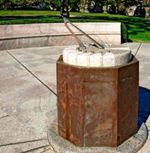 |
New London |
Connecticut |
USA |
Horizontal Dial |
Dial 473 |
| A horizontal dial of striking modern design about 24 inches in diameter. The dial face is granite with milled wedges, leaving hour lines from 6 am to 6 pm. Hours are represented by small round bronze markers. The gnomon is of unusual design. When installed, the gnomon had a vertical glass plate below the style. The dial doubled as a fountain - water flowed from the top of the gnomon down the glass plate. Each of the bronze hour markers also had a small spray of water. The round granite dial is slightly smaller than the octagonal pedestal and base. A small trough between them recovers water from the fountain. |
| |
| |
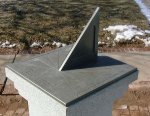 |
Amherst |
Nova Scotia |
Canada |
Horizontal Dial |
Dial 472 |
| A Centennial Dial for Amherst, this is a square horizontal dial with clean design about 18 x 18 inches. The dial face and triangular gnomon are cast bronze sitting upon a granite pedestal. The dial has hour lines and Roman numerals from IIII (morning) to VIII (evening) and tick marks for the quarter hours. An accompanying display explains the function of the sundial and contains a table for the Equation of Time, including longitudinal correction. |
| |
| |
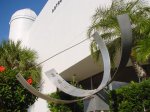 |
Cocoa |
Florida |
USA |
Equatorial Dial |
Dial 471 |
| This is a simple equatorial dial 58 inches wide and 49.5 inches high. Because of the low latitude, the 6 inch wide equatorial band has Roman hour markings only from 7am to 5 pm. The gnomon is a thin, unadorned rod. The dial base is a square box with canted top to the Florida latitude, supporting the equatorial cross members. |
| |
| |
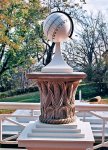 |
Monticello |
Virginia |
USA |
Globe or Hemispheric |
Dial 470 |
| A replica of Jefferson's lost dial, which he recounted in 1817, "My dial captivates every body foreign as well as home-bred, as a handsome object & accurate measurer of time." Made according to Jefferson's design, the replica dial is a 10 1/2 inch painted wood sphere with horizontal lines drawn for the equator, Tropics of Cancer and Capricorn. Longitudinal lines are drawn between the two tropics to indicate the hours of the day. A gnomon fixed to the poles swings around the globe until it casts the smallest meridian shadow. The original sphere was made of black locust wood but the replica is mahogany because it is "more durable, stable and easier to find." The base was originally a model of a capital, the top part of a column, that Latrobe had designed for the U.S. Capitol. It was unique, featuring ears of corn in motif. When Jefferson received the base from Latrove, "it looked bald for want of something to crown it" and so Jefferson designed a globe that "might be made to perform the functions of a dial." |
| |
| |
 |
Pinawa |
Manitoba |
Canada |
Horizontal Dial |
Dial 469 |
| The Pinawa Heritage Sundial located in the center of town was constructed as a city wide effort to create pride and focus. The 17.5 foot high horizontal sundial has a gnomon constructed of steel and the 38.5 by 40.5 foot base is constructed of polished granite, rail, and granite stones. The sundial has two sets of time markers. An outer dial ring indicates local apparent time, while an inner dial ring indicates zonal solar time. Forming an integral part of the sundial, 12 icons were designed and constructed, illustrating the history of the region and its people. |
| |
| |
|
Niagara Falls |
Ontario |
Canada |
Armillary Sphere |
Dial 468 |
| A small 18 to 24 inch armillary sphere. Has a traditional arrow marking the gnomon. It sits on a pedestal in the center of the herb garden. |
| |
| |
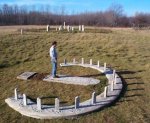 |
Big Bay |
Ontario |
Canada |
Analemmatic Dial |
Dial 467 |
| This is a nicely constructed analemmatic dial, made of concrete, stone and ceramic tile. The hour markers are a series of small posts set in a continuous elliptical path with a 6 meter major axis and 4 meter minor axis. The sundial is located in a field next to a megalithic henge at Keppel Croft Farm and Gardens. |
| |
| |
 |
Thunder Bay |
Ontario |
Canada |
Analemmatic Dial |
Dial 466 |
| A very well constructed analemmatic dial about 24 by 11 feet. The dial may be difficult to find, since it is in the center of a field that is devoted to wild grass of the area. Cement markers are used to show the hours and for the central base showing the months where to stand. The hourly markers are corrected for the longitude of Thunder Bay. The site is visited quite frequently by school children and is a great educational tool for dialing. |
| |
| |
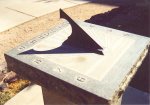 |
Tucson |
Arizona |
USA |
Horizontal Dial |
Dial 465 |
| A simple square horizontal dial 20 x 20 inches carved in a 3 inch block of granite with a bronze gnomon. The dial has hour lines from 6am to 6pm for local solar time. No graph or table for longitude and Equation of Time corrections. Dial sits atop a 3 foot square pedestal. |
| |
| |
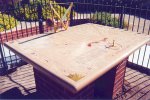 |
Tucson |
Arizona |
USA |
Horizontal Dial |
Dial 464 |
| A horizontal sundial 45 x 61 inches with a monofilar brass cable gnomon and tension counterweight. This is the largest horizontal sundial in the US carved on a single piece of stone, taking two years to build. The dial has hour lines from 5am to 8pm, corrected for longitude. Each hour line has an analemma and in the lower right of the dial is a graph of the Equation of Time. A nodus on the wire gnomon indicates date, with declension lines for summer and winter solstice, equinox, and date lines. Time and direction of sunrise and sunset are marked on the equinox and solstice lines. At the base of the gnomon is a 16-point compass rose. On the left side of the dial is a table for telling time by moon shadows. In the center is a copy of the hands from "The Creation" by Michelangelo. |
| |
| |
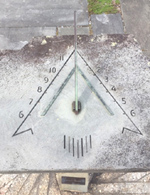 |
Ithaca |
New York |
USA |
Horizontal Dial |
Dial 463 |
| A horizontal sundial made from a an irregular slab of stone approximately 18 x 24 inches. The hour markings are inscribed in the form of an arrow pointing to the 12 o'clock hour and the gnomon is a thin blade. In keeping with the herb garden's design, maker and designer Michael Sweeney used native materials of stone for the dial and pedestal. The dial base was a prized antique millstone of orange granite from a nearby village. |
| |
| |
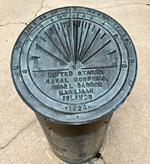 |
Bethesda |
Maryland |
United States |
Horizontal Dial |
Dial 462 |
| Farenholt sundial for U.S. Naval Hospital Pearl Harbor, Hawaiian Islands. This cast bronze dial was designed and commissioned by RADM Farenholt for U.S. Naval Hospitals at bases where he was commanding officer, visited, or had special meaning to him. The dial is 18 inches (46cm) in diameter. The outer chapter ring has the motto, followed by a chapter ring with Arabic hours 6am to 6pm, raised hour lines that radiate from near the foot of the gnomon and short half-hour lines. The gnomon has graceful curves and a quatrefoil cut-out in the center. Below the gnomon is the naval command name, followed by the commissioning date in the southern portion of the hours chapter ring. |
| |
| |
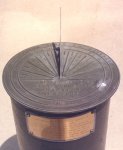 |
Bethesda |
Maryland |
United States |
Horizontal Dial |
Dial 461 |
| Farenholt sundial for U.S. Naval Hospital Brooklyn NY. This cast bronze dial was designed and commissioned by RADM Farenholt for U.S. Naval Hospitals at bases where he was commanding officer, visited, or had special meaning to him. The dial is 18 inches (46cm) in diameter. The outer chapter ring has the motto, followed by a chapter ring with Arabic hours 6am to 6pm, raised hour lines that radiate from near the foot of the gnomon and short half-hour lines. The gnomon has graceful curves and a trefoil cut-out in the center. Below the gnomon is the naval command name, followed by the commissioning date in the southern portion of the hours chapter ring. |
| |
| |
|
Newark |
Ohio |
USA |
Analemmatic Dial |
Dial 460 |
| An analemmatic dial with stone markers for the hours |
| |
| |
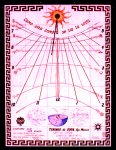 |
Tenango de Doria |
Hidalgo |
Mexico |
Vertical Dial |
Dial 459 |
| A very striking vertical reclining dial 85 x 115 cm created from hand painted tiles, each individually fired in a kiln and assembled at Tenango de Doria by David Canyedo. In addition to hour lines, the dial includes declination lines for the solstices and equinox. The dial includes constellation maps of both the northern and southern hemispheres, a celestial sphere, and rose of winds (compass). The artistry also includes NAHUI OLLIN (the fifth sun which is the era we are living in according to the Aztecs). The dial has an equation of time that allows conversion from local solar time to standard time. The dial was designed to arouse interest of high school students in astronomy. |
| |
| |
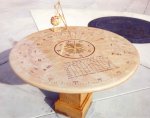 |
Bullhead City |
Arizona |
USA |
Horizontal Dial |
Dial 458 |
| This horizontal dial is an engraved flagstone approximately 42 inches in diameter designed by John Carmichael. The monofilar gnomon is a stranded brass cable that extends upward to a height of 18 inches and is held taught by a rock counterweight. Hour lines and direction of sunrise and sunset for the equinoxes and solstices are given. Also has noon Mark, The Equation of time, and a 32-point Compass Rosette |
| |
| |
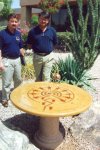 |
Casa Grande |
Arizona |
USA |
Horizontal Dial |
Dial 457 |
| This horizontal dial is an engraved flagstone approximately 40 inches in diameter designed by John Carmichael. The monofilar gnomon is a stranded brass cable that extends upward to a height of 15 inches and is held taught by a rock counterweight. The engraved stone shows time marks to 5 minutes, corrected for longitude. Time and direction of sunrise and sunset for the equinoxes and solstices are also given. |
| |
| |
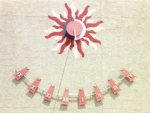 |
Tucson |
Arizona |
USA |
Vertical Dial |
Dial 456 |
| This is a 10 x 10 foot south vertical wall dial with hour lines painted on the wall that are corrected for longitude. A unique feature of this dial is the time scale can be rotated forward or back slightly to compensate for the Equation of Time. However, because only the hours are marked, precise minute reading is difficult. Welded steel was used to make the time marker ring and gnomon. |
| |
| |
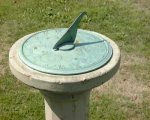 |
Halifax |
Nova Scotia |
Canada |
Horizontal Dial |
Dial 455 |
| This bronze horizontal dial is approximately 25 cm across on a one-meter high pedestal. Both the dial and dedication plate have a blue-green patina. The gnomon is slightly bent and appears to have been re-attached to the dial. The orientation remains true. Roman numerals mark the hours from 5 am to 7 pm. Hour lines plus half-hour marks. The concrete base is badly cracked and small pieces have fallen away. The dial is well-situated in an open area, but a nearby tree might shade the dial near midday during fall, winter, and spring. |
| |
| |
 |
Juneau |
Alaska |
USA |
Analemmatic Dial |
Dial 454 |
| Painted on a downtown sidewalk is an analemmatic sundial for public use. The 25 x 20 foot sundial was organized as a community project. Eden Orelove, niece of designer Michael Orelove said, "We wanted to get as many school classes and local volunteer organizations involved as possible." Groups were invited to join the project by painting the hourly numbers. Two concentric ring of numbers are used to indicate both standard and daylight saving time, which extends from 4 am to 10 pm. |
| |
| |
 |
Mexico City |
Distrito Federal |
Mexico |
Horizontal Dial |
Dial 453 |
| A triangular based horizontal dial with a triangular moat. The outer triangular sides are approximately 12 feet (4 meters). The dial and moat are built of concrete, with an aluminum or sheet metal gnomon about 150 cm. On the dial are metal pyramids to indicate hours. The sundial was donated by the Tecnologico de Monterrey University. |
| |
| |
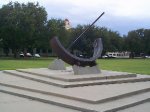 |
Las Cruces |
New Mexico |
USA |
Equatorial Dial |
Dial 452 |
| A large equatorial dial with steel gnomon. The massive dial is set simply on a set of tiered platforms. The inner tiers are rotated from the outer to align to the cardinal points. Elsie Raye Rigney Carr and Dr. Jesse Lawrence Carr gave the dial to the university in 1975 in memory of Raye Hines Rigney, Class of 1911. |
| |
| |
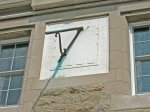 |
Elizabethtown |
Pennsylvania |
USA |
Vertical Dial |
Dial 451 |
| A 4x4 foot marble vertical dial declining 25° east of south with a copper gnomon, located above the center entrance of the Grand Lodge Hall and overlooking the formal garden of the Masonic Village of Elizabethtown. The dial face includes hour lines with half hour and ten minute marks and Roman numerals. An inscription, "ANNO DOMINI MCMXII" is located above the gnomon. The dial declines 25° east of south. |
| |
| |
 |
Kingston |
Ontario |
Canada |
Vertical Dial |
Dial 450 |
| A square pillar of limestone rocks 4 foot on a side and 15 feet high with a small bowl and sphere on top hold two vertical dials each 2x2 feet. The pillar faces are oriented SE and SW allowing for two declining dials. The dials are of solid brass and have hour lines with Arabic numbers in a modern design belying by the stonework of the pillars. Unfortunately the 14-inch gnomons are bent |
| |
| |
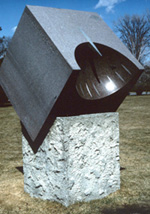 |
Ottawa |
Ontario |
Canada |
Globe or Hemispheric |
Dial 449 |
| This hemispherium dial is a dramatic modern sculpture. The 32 inch quarter hemisphere is carved into the edge of a 40 inch cube of dark granite tilted to conform to its latitude of 45.5° , and set upon a rough concrete pedestal of slightly smaller dimension. The gnomon is a |
| |
| |
 |
Calgary |
Alberta |
Canada |
Equatorial Dial |
Dial 448 |
| A steel and brass equatorial dial 49 inches in diameter. The dial simulates an armillary sphere with two crossed semi-circles in a modernistic sculpture. There is a slot in the gnomon that projects a sun line and corrects for the equation of time; the gnomon is turned over at the solstice. Fine adjustments are required near the solstice to show correct clock time (MST). Dial built as a Canadian Centennial Project.
Now relocated to a mid-level landing on the entrance stairs but not correctly aligned, producing a 48 minute error. |
| |
| |
 |
Bloomington |
Minnesota |
USA |
Equatorial Dial |
Dial 447 |
| An Erickson Monument polar equatorial dial of light granite, approximately 5 feet (1.5m) in diameter and 6 inches (15cm) thick. The gnomon shaft is steel, 3 inches (7.5cm) in diameter, extending from the ground through the dial plate and outward another 18 inches (46cm). The base is a simple tier of raised concrete. 24 hours of radiating lines are inscribed on each side of the dial (summer and winter), ending with the hour in Arabic numbers. Time is graduated by half-hour and 5 minute marks. Numbers on the summer side follow the shadow clockwise. But during winter, looking at the reverse side, the hourly numbers accommodate a shadow that moves counterclockwise. Numbering of both summer and winter hours is overly aggressive, starting at 2am and extending to 10pm. Two equation of time graphs, each about 3 x 5 feet engraved in granite, are set at the north and south ends of the dial, providing corrections from Apr-Sep, and Oct-Mar. [The description to obtain watch time attributes Bloomington's longitude as 93:18 East instead of West. Further, it tells the user to subtract one hour for daylight savings time.] Nearly identical to the Port Arthur Dial, Texas, but without city names located in various time zones. |
| |
| |
 |
Port Arthur |
Texas |
USA |
Equatorial Dial |
Dial 446 |
| A large Erickson Monument polar equatorial dial of light colored granite, approximately 6 feet in diameter and 6 inches thick. The gnomon shaft is steel, extending from the ground through the dial plate and outward another two feet. The base is a simple tier of raised concrete. 24 hours are inscribed on each side of the dial (summer and winter) as radiating lines with Arabic numbers at the end. Time is graduated by half-hour and 5 minute marks. Two equation of time graphs, each about 3 x 6 feet engraved in granite, are set at the north and south ends of the dial, providing corrections from Apr-Sep, and Oct-Mar. [An interesting note about the engraving for the Apr-Sep graph: The line originally said "For daylight savings time, subtract one hour", the word "subtract" was filled in and "you add" was inscribed over it.] In the top quadrant of the dial (both obverse and reverse) where the sun's shadow will never cast, are the names of cities in 16 different Time Zones. A beautiful and well-crafted sundial, it makes a fitting Seaman's Memorial. |
| |
| |
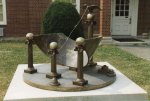 |
Lewisburg |
Pennsylvania |
USA |
Cylindrical Dial |
Dial 445 |
| A large, ornate equatorial dial of brass sits outside the physics department building. The dial is approximately 8 ft (2.4m) across. Two pillars with brass balls support the dial plate. Two more pillars with ball support the gnomon wire. To add a flourish, the north most pillar and ball have a spread eagle holding the gnomon wire in its mouth. Unfortunately this beautiful dial is tarnished by age, with the analemmas for each hour barely visible on the dial plate. The gnomon wire, broken sometime in the past, is jury-rigged and tied together in the middle, resulting in a unkempt look to such a fine dial. A dark, round stone base, perhaps made of slate, approximately 8 ft (2.4) in diameter supports the dial and pillars. The stone sits upon a 10 x 10 ft (3m) concrete pad. |
| |
| |
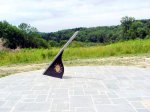 |
Wilmot |
Ohio |
USA |
Horizontal Dial |
Dial 444 |
| The Wilderness Center Sundial is large horizontal dial with a 6-foot steel gnomon approximately 27 inches thick. The base is done in slate with copper numbers. |
| |
| |
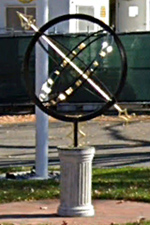 |
Newburyport |
Massachusetts |
USA |
Armillary Sphere |
Dial 443 |
| This 4-ft (1.2m) diameter armillary sphere is made of galvanized, painted and gold leafed steel. The dial was forged and welded by Cassidy Brothers Forge. It was "Colorgalvanized" by Duncan Industries and gold leafed. It was made to specifications from Albert Waugh's book on sundials, including latitude and longitude corrections. The sundial is mounted on a cast stone pedestal and stands about 8-ft (2.4m) high. |
| |
| |
 |
Watertown |
New York |
USA |
Vertical Dial |
Dial 442 |
| The vertical dial is on one face of a ornamental rectangular display raised on pole at the edge of the street at Key Bank Clock Plaza. The dial is approximately 2-foot square with an ornate gnomon having a "key" cutout. The dial was moved from another location to the present pole and restored. The dial is made of copper or bronze. Nearby is a plaque with the equation of
time. Dedicated May 15, 1967. |
| |
| |
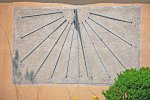 |
Somerville |
Massachusetts |
USA |
Vertical Dial |
Dial 441 |
| This 5 foot x 7 foot vertical dial is painted onto the true south facing concrete wall of a commercial building. The gnomon and hour lines appear to be weathered copper or bronze. The hour lines are corrected for longitude, but may be in error by about 5 minutes. The dial is in relatively good condition, but the painted numerals are fading. The building itself has been in several hands over the last 10-15 years. |
| |